7 Best Bass Guitar for Beginners – Getting Started With The Bass
We may also earn commissions on purchases from other retail websites.
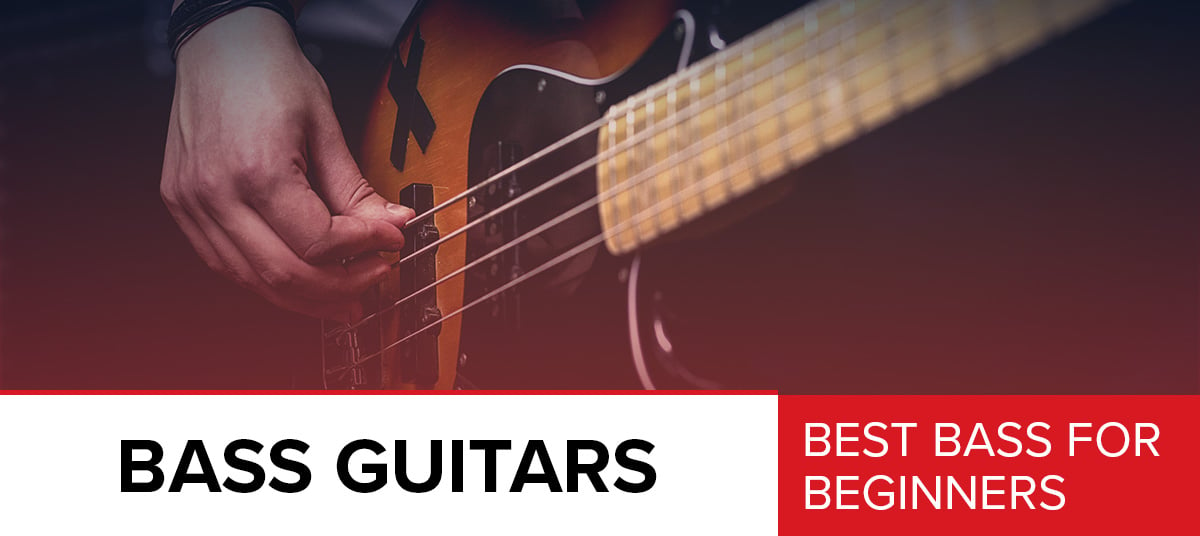
Learning to play the bass guitar can be both exciting and a little tricky. Regardless of your current skill level, playing bass requires a completely different approach to an electric guitar. For example, the bass is played in a deeper register, has a longer neck, thicker strings, is played with different techniques, and has a specific role in a band scenario.Last Updated: May-07-2019
In our new refresh of this important bass article, we moved a few things around with our chart. We removed the older Ibanez SR370, and replaced it with the Jackson JS Series Spectra Bass JS2, while moving the cool Sterling by Music Man S.U.B. Series Ray4 to the top spot!
Your job as a bass player is to bridge the gap between the drummer and the rest of the band, thus keeping everything in sync. Although there is also plenty of room to steal the limelight with a bass, don’t worry!
While we aren’t here to teach you how to play, we can help with one of the main issues that beginners have at the start of their journey – selecting their first bass guitar.
There are just so many models on the market, with different features and components available. Overwhelming is an understatement!
This short guide contains all the information you will need to both pick the right model for you as you start on your bass journey, as well as some tips, recommendations and general information on how to choose a bass guitar and what to look for when shopping.
The following chart highlights a handful of the top-rated bass guitars for beginners. By the time you’re done reading, you should have enough info to pick out a bass that fits you like a glove!
Top 7 Best Bass Guitars For Beginners:
| Image | Bass Guitar / Rating | Summary | Check Price |
|---|---|---|---|
+ -  | Sterling by Music Man S.U.B. Series Ray4 Total of 4.88/5 | Model which offers a good part of that awesome Music Man experience. | |
+ -  | Schecter Omen 4 Total of 4.88/5 | Capable bass with taste for metal, but a versatile tone as well. | |
+ - 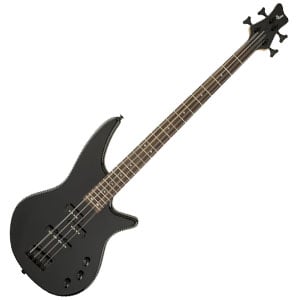 | Jackson Series Spectra JS2 Total of 4.45/5 | A versatile bass that will make a beginner feel like a rock star. | |
+ -  | Yamaha TRBX174EW Total of 4.66/5 | Great style and playability from this affordable exotic wood bass. | |
+ -  | Ibanez GSRM20 Total of 4.86/5 | The ideal short-scale bass for smaller beginners. | |
+ - 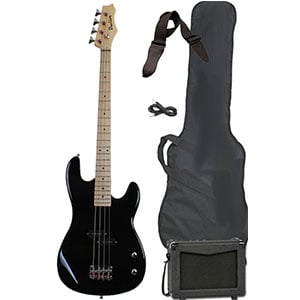 | Davison Full Size Electric Bass Starter Pack Total of 4.10/5 | A very cheap pack that’s very basic, but great for beginners. | |
+ -  | Squier Vintage Modified Jaguar Bass Special SS Total of 4.62/5 | Affordable classic Jaguar bass with a beginner-friendly short scale. |
Sterling by Music Man S.U.B. Series Ray4
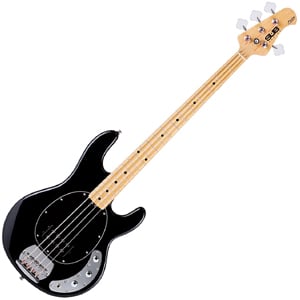
| Body And Neck: |  |
| Electronics: |  |
| Hardware: |  |
| Sound: |  |
| Value: |  |
Music Man bass guitars have always been an authority in top tier segment of the market. Aside from their impressive performance and quality, Music Man instruments are also known for their pretty exclusive price. Sterling is a company that has a relationship with Music Man which is similar to that between Squier and Fender.
Sterling by Music Man S.U.B. Series Ray4 is an affordable version of the original Sting Ray series, and the sound you get is one of the better in its respective segment. The tone is hard hitting and rich in terms of output power. You can dial in a wide range of tone styles thanks to a versatile active humbucker and a two-band EQ that comes with it.
As a beginners bass guitar, you can count on Sterling by Music Man S.U.B. Series Ray4 to meet all of your requirements as you progress from beginner to advanced player. Even then, you will hardly find it to be limiting. While it is a bit more expensive, Sterling by Music Man S.U.B. Series Ray4 is worth the investment.
Schecter Omen 4
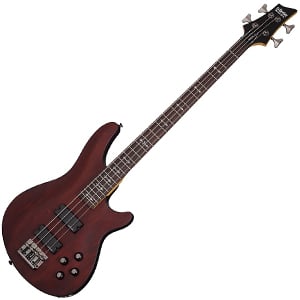
| Body And Neck: |  |
| Electronics: |  |
| Hardware: |  |
| Sound: |  |
| Value: |  |
Schecter has proven to be one of the most trusted brands when it comes to getting performance on a budget. On average, all of their models punch above their weight class in some way. Schecter Omen 4 is one of their models which shows you perfectly what we meant with that statement.
While many will tell you it’s made for metal, which definitely isn’t a lie, this model’s spectrum of capabilities is much wider than that. Compared to other Schecters, Omen 4 looks pretty neutral and nonaggressive. It comes with an active set of pickups, a great two band EQ section, and an appearance that puts many other basses in this segment to shame.
The tone it offers is pretty versatile. With two hot humbuckers, you can get that sharpness for precision work, while at the same time being able to muddy up the waters with a nice, fat tone. As a starter, this is the type that will serve you well for a long time.
Jackson Series Spectra JS2

| Body And Neck: |  |
| Hardware: |  |
| Sound: |  |
| Value: |  |
Another solid choice on this list is the new JS2 bass from Jackson Guitars – part of the brand’s Spectra Series, released in early 2019. Aimed primarily at entry-level players, this versatile bass looks every bit a winner.
The new offset body design makes this bass look cool and feel sleek, while the materials keep the cost down. The P/J pickup configurations provide the expected versatility and familiarity, while an added bass boost control gives it an edge over some competitors.
This bass seems to be a statement of intent from Jackson Guitars. The prolific manufacturer certainly isn't slowing down and – if this is a sign of things to come – we can’t wait. Check out our full Jackson Series Spectra JS2 review for all the details.
Yamaha TRBX174EW
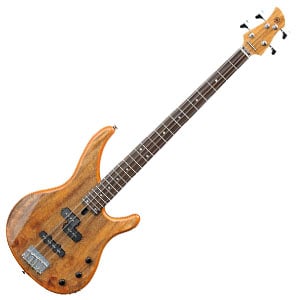
| Body And Neck: |  |
| Electronics: |  |
| Hardware: |  |
| Sound: |  |
| Value: |  |
The TRBX174EW sits at the lower end of Yamaha’s popular TRBX bass series, but this makes it the perfect prospect for beginners. The bass has a unique look, thanks to an attractive layer of exotic mango wood on the top.
The bulk of the body is made from mahogany, which is quite light and well-contoured for a comfortable feel whether standing or sitting. There’s an easy-playing bolt-on maple neck with a rosewood fretboard and a full 24 frets.
As we mention in our full review of the TRBX174EW it features both a split Precision-style single-coil and a Jazz-style single-coil, with tone and volume controls, for good versatility. For a mass-produced bass it is certainly punching above its weight when it comes to craftsmanship.
Ibanez GSRM20
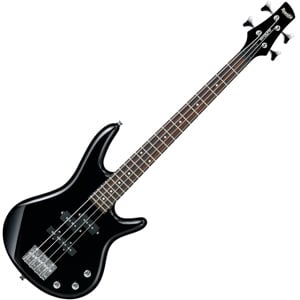
| Body And Neck: |  |
| Electronics: |  |
| Hardware: |  |
| Sound: |  |
| Value: |  |
Next, we want to show you is a very special little axe from Ibanez. This is one of their short scale models which have swept the market like a forest fire. In many ways, this bass is very similar to their GSR200 model, only it comes with a shorter neck.
What are the benefits of such design? Well, first and foremost, it’s much easier to play, both for beginners and those who have smaller hands. While it might feel like you’re losing something by having a few inches cut off from the scale, the fact is that the difference is marginal at best.
Build quality is more than decent, sporting a nice combination of Agathis body and a standard maple neck. hardware is solid and holds the tuning just fine, while the pickups give you a decent range of tones to play with.
Davison Full Size Electric Bass Starter Pack

| Body And Neck: |  |
| Hardware: |  |
| Sound: |  |
| Value: |  |
We did have to take a bit of time to decide whether we were ruining the integrity of this list by adding such a cheap bass, but – after spending some time with this pack – there was no way we could leave it off!
This very wallet-friendly starter pack includes everything you need to get up and running on bass, including a small amplifier, a strap, a lead and a soft gig bag. Of course, taking center stage is the bass itself which is very basic but performs well and gives beginners a good platform on which to learn.
It features one split-coil pickup and simple controls, while the amp is also easy to get to grips with. There’s more on this inexpensive pack in the full review!
Squier Vintage Modified Jaguar Bass Special SS
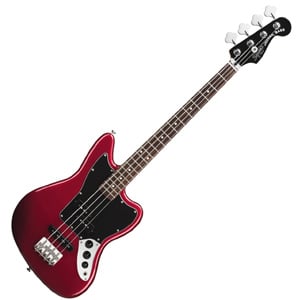
| Body And Neck: |  |
| Electronics: |  |
| Hardware: |  |
| Sound: |  |
| Value: |  |
Beginners with small hands will feel at home with this Vintage Modified Jaguar from Squier, which has an easier-to-play 30” scale length. With three colors to choose from this model sports the classic Jaguar body, made from agathis, with a bolt-on maple neck, 20 frets and a rosewood fretboard.
The pickups are nothing special and aren’t as powerful as you may expect, but certainly do the job – especially at this affordable price range. There’s a split single-coil Precision Bass pickup at the middle position, with a single-coil Jazz Bass pickup at the bridge, controlled by two volume knobs, and a master tone control.
Make sure to check out our full review of this cool Squier Vintage Modified Jaguar Special SS.
Buyer’s Guide for Your Beginner Bass Guitar
Most of the time, selecting your first bass is going to be as easy as heading into your local guitar store, pointing at one, and saying ‘that’s the bass for me!’.
However, it’s not always that straightforward. Before making a rash decision and being left with a bass that’s not ideal for your needs, consider the following points:
Budget
When it comes to a budget, there is no maximum amount you can spend on a bass guitar. Fancy a ’67 Rickenbacker? That will be $23,000 please!
Vintage bass legends aside, you can realistically spend hundreds of dollars on your first bass – but you don’t have to. While everyone is different, our rule of thumb is: spend as much as you can afford. A cheap bass coming in at under $150 will certainly do the job, but if you can afford to stretch into the $200 to $400 range, you will find a lot more choice and a better-quality instrument overall.
The advantage of learning on a better-quality instrument is that it will usually be more comfortable to play, and that you will have more tone and power at your disposal, allowing you to grow into the instrument.
However, going over the $500 mark as a beginner isn’t necessary, until you build up some skill and experience. Although if you have an endless supply of cash and fancy a $2,000 starter bass, then don’t let us stop you!
Comfort
Learning how to play a new stringed instrument is always going to be a little uncomfortable. Bass takes that discomfort to a whole new level! As it has a much longer scale length than an electric guitar, you will be learning to stretch and spread your fingers much further than you would have to on a guitar.
While this will take everybody some time to adapt to, in some rare cases, a person simply won’t be able to play comfortably on a standard scale bass. The solution? Buy a short scale model (these are well represented in our beginner’s chart).
The shape of the body also matters. Some bass guitars are a little larger than others, while the balance of the instrument can be a problem, especially with more affordable models.
Ultimately, finding a bass guitar that is comfortable for you to play is definitely something worth doing. If you are a smaller person or shopping for a teenager, a short-scale bass could be a good move, so keep it in mind.
Number of Strings
Bass guitars are traditionally four stringed instruments, although models with five and six strings are available and more popular than ever. However, we suggest that you stick with four strings in the beginning. As a beginner, that’s complicated enough.
As you develop some skills, you can then move over to a 5-string bass if you wish to explore new styles and broaden your horizons. But, as you just start out on bass, a model with four strings will suit you just fine (look at somebody like Flea – he’s never been limited in any way!)
Electronics
Bass guitars come with two different types of electronics – just like electric guitars. You have both passive and active models, both with their own benefits and flaws.
Passive pickups are more common on beginner bass guitars. These tend to be cheaper to produce, don’t require an external power source (like a battery) to work, and are generally more expressive in tone.
On the other hand, active pickups are much hotter, which means they have a more powerful and articulate output, but are more expensive and usually require a battery to operate.
As a beginner, the choice of electronics is not something you should worry about too much. Passive pickups are just fine until you develop a taste for tone. Then you can really assess whether a passive or active setup works best for you.
Pickup Layout
Affordable models tend to come in a few standard pickup layouts – all of which are worth familiarizing yourself with.
First you have a Precision layout, which is probably the most distinctive type. It consists of one split-coil pickup at the neck position. The benefits of this layout include a fatter tone, great reliability and an overall lower cost.
Next is the Jazz layout, which is another popular style. This layout includes two single-coil pickups – one at the bridge and one at the neck. This setup offers more versatility and clarity, but lacks some growl when compared to the Precision layout.
Another option is the P/J layout. This is probably the most common layout you will find and is a ‘best of both worlds’ solution (mixing the Precision and Jazz layouts together). Basses that have this type of pickup configuration come with a split-coil pickup at the neck and a single-coil at the bridge. A P/J layout combines the benefits of the previous two configurations, offering a decent middle of the road solution.
Finally, there is a standard double pickup layout which can include both single-coils or humbuckers, depending on the model you are looking at.
Generally, each one of these pickup configurations is great, and choosing one comes down to personal taste. As someone who is just starting out, you won’t make a mistake if you go for any of the four.
What is the Easiest Type of Bass Guitar to Play?
We mentioned this earlier, but it’s worth repeating. A 4-string bass is the best style to learn on. While 5-string and 6-string basses are becoming more and more popular, offering players in all genres a new way to express themselves musically, they add unnecessary complication.
A 4-string bass is easier to understand and to play. The necks are narrower and therefore easier to play (try stretching around a 6-string bass neck and you’ll see what we mean!).
The fact is that the majority of songs you will learn to play won’t require the extra string anyway. Even if you are keen on learning a certain style of music that does make use of the extra string (modern metal for example), we still recommend you learn on a 4-string bass, then make the step up when you are more comfortable.
Whatever bass you end up on, we always recommend you have it set up properly. This will mean the string action is nice and low, which always makes the bass easier to play. You can do this yourself (by following how-to videos like the one below) or by taking it to a local pro.
What Do You Need to Play Bass Guitar?
You’ve bought the bass – great! What else do you need?
An amplifier should be the next thing on your list and ideally bought at the same time as the bass. While you can certainly ‘dry practice’ (playing unplugged), practicing through an amplifier will give you important feedback on your technique and allow you to develop good playing habits. Plus, an amp is essential if you are jamming or performing with a band.
Of course, the amp wattage you need will be determined by why and where you are performing. See our page on bass amps for more information on this. However, as a beginner, a small practice amp (between 10 and 40-watts) will do the job for now.
To plug into the amp, you will also need a decent instrument cable, which will work for both guitar and bass. You can spend as little as a few bucks, but aim to buy something between $10 and $20, which will give you a much better tone and will last longer.
You may want to buy a couple of plectrums too. While bass is traditionally played with fingers, some bassists – especially in the punk, rock and metal genres – like to play with a pick, which can deliver a more defined, aggressive sound.
Finally, it may be worth investing in an inexpensive guitar tuner, which will help you easily tune your bass, as well as a decent case/gig bag to store and transport the instrument.
To sum up, here’s our quick bass checklist to get you up and running.
• Bass
• Amp
• Cable
• Plectrums (optional)
• Tuner
• Case
Needless to say, we have guides covering all of the stuff above, so check them out for further help.
How Much Should You Pay for a Beginner Bass Guitar?
It’s a great question and one we touched upon earlier in this article. Yet, it’s one with no definitive answer!
Naturally, learning on a gorgeous $5,000 custom bass with a sleek neck and high-end pickups will certainly encourage you to sit down and practice! But we can’t all afford one of these.
Thankfully it’s not necessary – or even that common – for beginners to spend much more than a couple of hundred bucks on a decent bass. Providing a budget bass can plug into an amp, give you a decent voice and play relatively well, that’s all you truly need to begin.
A budget bass is a solid choice for all beginners, especially if you are just testing the water. If you aren’t sure if bass is even the right instrument for you, why spend more than you need to trying it out?
However, if you feel you are a Geddy Lee in the making and have your future firmly fixed on the stage, then extending your search to something in the under $300 market wouldn’t hurt. This would give you a solid model with great playability that you won’t outgrow too quickly.
Should You Buy a Used Bass?
Buying a used instrument is a route that a lot of beginners take. The used market can result in a real bargain, but it also introduces a number of problems.
Unless you have a very experienced player with you, chances are you won’t be able to recognize some red flags (indicating damage or faulty electrics) that usually come with used instruments. If possible, make sure to try a used instrument through an amp before parting with your cash.
Going for a new bass guitar from a trusted marketplace eliminates the risk of damage or faulty electrics, especially when you have a returns policy and warranty to fall back on. The decision is yours, but be careful – for every bargain, there are five duds!
The Final Word
If you’re just starting your journey in the wonderful world of bass guitar, then congratulations on making the first step. You’ll find it can be an exciting but confusing time, especially with the amount of bass guitars on the market and the amount of information thrown at you (sorry – we tried to keep it brief!).
The models we have featured in our chart above are undoubtedly some of the best affordable beginner models on the market today, and we hope the accompanying short guide has armed you with the right advice to allow you to make an informed decision.
Anything that costs more than the models we’ve listed here may be best left until you figure out exactly what you want from your instrument. Reaching that point takes time and a lot of practice. Whatever you choose, good luck!




Andrew says
I love the guide, thanks a lot.